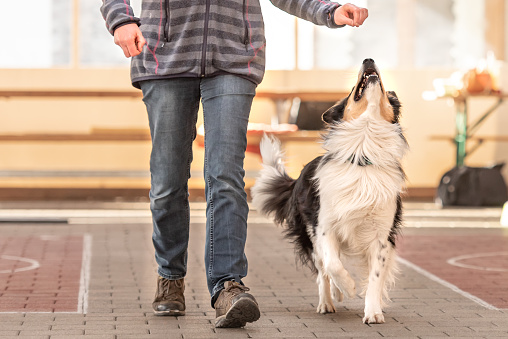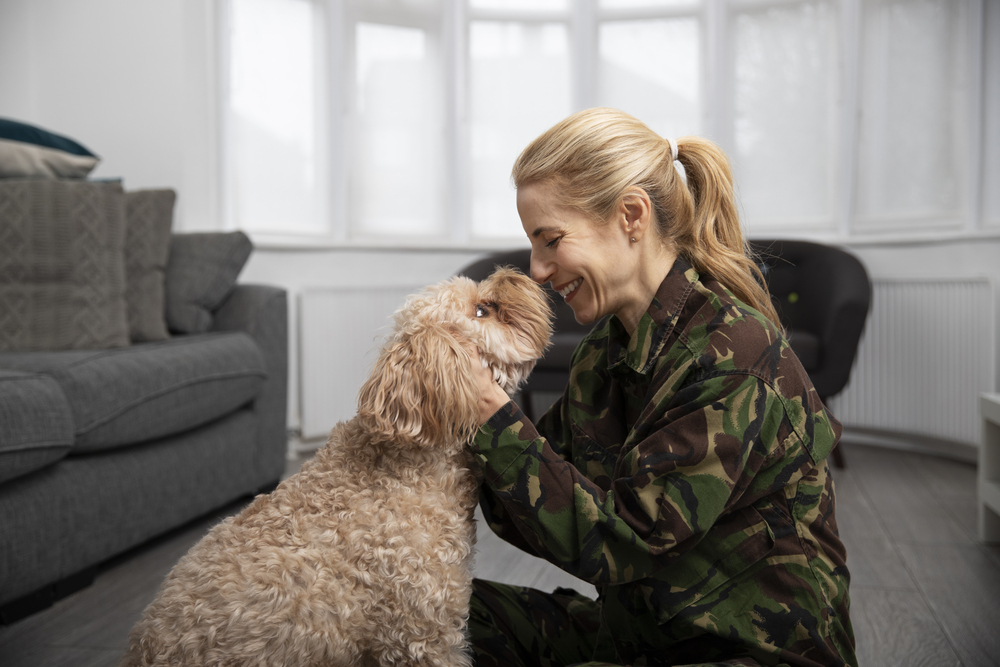- Service Dog Training Schools
- Who Is Eligible for a PSD?
- Does the Dog Have the Right Temperament to Become a PSD?
- PSD Training
- Maintain the Progress / Keep in Touch with the Customer
- Do Emotional Support Animals Qualify as Psychiatric Service Dogs?
- Should PSDs be Certified or Registered?
- Should PSDs Wear a Vest or Any Identification Gear?

People with both physical and mental disabilities are eligible for a service dog. Controversy in regard to whether Psychiatric Service Dogs are “real” service dogs or not has gradually been overcome. Service animals performing tasks directly related to a mental disability must be granted public access rights, as they, just like the service animals supporting people with physical impairments, are considered medical equipment.
Training a Psychiatric Service Dog (PSD) is a process that requires knowledge, a lot of practice, time, patience and consistency. Whether owner-trained or trained with the help of a professionalist, people interested in training a PSD, should consider the specifics of the process and take many factors into account.
Service Dog Training Schools
There is no government-approved certification for dog trainers on a federal or state level. If you've decided to go the way of becoming a service dog trainer, you may want to look for apprenticeships at training schools and professional trainers. By graduating from one of their service dog programs, you will be able to verify that you gained knowledge and acquired skills in this field. Often, successful trainers have a good reputation and rely on their students to recommend their services.
If you are looking for a reputable school that offers accredited education, you may want to check the Bergin University of Canine Studies- it is accredited by the Accrediting Council for Independent Colleges and Schools (ACICS) to award Associate's Degrees, Bachelor's Degrees and Master's Degrees. Other options are the Association of Professional Dog Trainers and the Certification Council for Professional Dog Trainers (CCPDT).
Who Is Eligible for a PSD?
The first step of the process is to determine whether a person (a client who is looking for a professional trainer or the handler themselves, in case they want to train their own PSD) is eligible for a service animal. According to the Americans with Disabilities Act (ADA) a person with a disability is a person, “who has a physical or mental impairment that substantially limits one or more major life activity. This includes people who have a record of such an impairment, even if they do not currently have a disability. It also includes individuals who do not have a disability but are regarded as having a disability. The ADA also makes it unlawful to discriminate against a person based on that person’s association with a person with a disability”. The term “disability” has been used as a legal term, and not as a medical one.
Examples of mental disabilities that qualify a person for a service dog can be:
-Anxiety;
-Depression;
-Panic disorders;
-PTSD;
-Schizophrenia;
-Bipolar disorder;
-OCD;
-Phobias;

Does the Dog Have the Right Temperament to Become a PSD?
This part of the process is crucial for training to succeed. We would like to affirm that there are no breed restrictions to what dog breeds can become service animals. The important thing is to determine if a dog as an individual has the right personality for the “job”. Of course, there are some breeds, that have become popular among service dog teams, due to their characteristics like intelligence, trainability, and friendly personality. Such breeds are: the Golden Retriever, the Labrador Retriever, the Poodle, the Border Collie, the German Shepherd...etc. However, the breed itself, does not automatically guarantee that the dog will become a great service dog. The best service dogs should be intelligent, calm, loyal, trainable, eager to please their owner, enjoy having physical contact, love being around people, and get along with animals.
You may wonder how you would be supposed to determine whether a pup has all these qualities or not... When meeting the pup for the first time, you should monitor how he/she responds to being petted, does he/she easily get scared, is he/she too shy or anxious. If the pup does not seem to enjoy having a physical contact, he/she seems to get scared too easily or is showing any signs of aggression, he/she would not be a good choice. Watching at the interactions between the other puppies of the same litter as well as the interactions with their mother, will give you an idea of what type of temperament your pup is likely to have. Also, the general appearance of the puppies should be considered-do they look healthy and well taken care of, or rather neglected. Asking about the health certificates of both parents will help you make sure that your future pup has not inherited any genetic disease.
PSD Training
Psychiatric Service Dog Training can be divided into two parts, both of which are essential for the dog’s ability to do his/her work.
Basic Obedience Training / Public Access
Prior to moving to advanced tasks, directly related to a person’s disability, a service dog should know how to behave properly, especially while in public. Employees are allowed to exclude from the premises service dogs who misbehave and are not under control.
Training a dog begins at the moment the dog enters his/her new home (usually not earlier than the age of 8 weeks). A puppy should be house-trained, and taught his/her boundaries.
Basic obedience training features several common skills, that every service dog should know: “sit”, “stay”, “come” (knowing his/her name and responding to it), “down”, and calmly walking on a leash, including “heel”. “Heel” means getting the dog at your side. When it refers to walking, the dog’s area from the head to the shoulders should be aligned with the owner’s hip. Usually “heel” is conducted on the left side.
The first steps toward training a PSD are crucial for developing a strong bond between the dog and handler. There are different types of techniques that can be applied to the training process. However, most trainers, including us, opt for positive reinforcement as the most effective one.
Positive Reinforcement
Positive reinforcement is very popular among dog trainers, whether professional trainers or owners, who have decided to train their own dogs. It keeps the dog motivated, and helps strengthen the bond between the handler and the dog. Positive reinforcement is based on encouraging the dog through giving rewards (usually treats), when the dog exhibits the wanted behavior. That way the dog learns that there will be a positive outcome if he/she shows the right behavior. If the dog is not food-driven, other motivators like toys can be used instead of treats.
Clicker Training
Clicker training is a simple and effective way to reinforce wanted behavior. When the dog fulfills a command (shows the wanted behavior) you should click and reward. Clickers are very effective when you want to introduce a new behavior and encourage your dog to continue showing it.
Distractions
PSD training should start in an environment without any or few distractions and gradually move to more busy areas. You should make sure that the dog knows how to behave while in public settings. The Americans with Disabilities Act (ADA) does not protect service dogs in training. However, many states allow service dogs in training to visit public places, which means that you may be able to practice in busy areas with more distractions. Also, based on the facility’s policy service dogs in training may be allowed.

Specialized Training for PSD Tasks
Deep Pressure Therapy and tactile stimulation are among the most popular tasks that PSDs perform. Usually there are two main approaches used to train a PSD in specialized tasks related to a mental disability. The first one is known as:
Association with Anxiety
This approach implies that the dog recognizes your symptoms and shows a certain behavior to notify you. In order to get your canine to recognize that something is happening outside your standard behavior, you should call him/her when you are having an episode, and reward him/her. Over time your canine is likely to understand that the anxiety episode is actually a cue and he/she will get a reward, if he/she comes to you.
The next step is to train your dog to do a specific thing / exhibits a certain behavior as a response. Some dogs have the innate ability to sense how their beloved human feels and perform various behaviors. However, in many cases the person does not understand right away what may cause the dog to behave in a certain way out of a sudden i.e. the dog starts barking or staring at them. During the training process you can train your dog the behavior that will make you feel better and that will mitigate your symptoms. This type of behavior can include giving a kiss, nose-nudging, pawing at you, laying on your lap, putting his/her chin on your lap...etc. What the exact behavior will be, is quite individual and depends on the person’s preferences.
Responding to Tells
The second approach is called “Responding to Tells”. Tells are a type of behavior, that the person exhibits when they are having an anxiety episode. They can be anything from rubbing your hands, panting, making a certain gesture, or using a specific phrase...etc. In order to train your dog to respond to your tells, you need to exhibit this specific behavior (.i.e rubbing your hands), then encourage your dog to do the trained response, (i.e. pawing at your leg). After enough repetitions, you can start increasing the duration between the new cue (rubbing your hands) and the old cue (the command for pawing at your leg). At some point your paw friend will understand that the new cue means the same thing as the old one and will understand what you are asking him/her to do. Once your dog shows the wanted behavior (pawing at your leg) after you have given the new cue only (rubbing your hands), you should praise him/her and give him/her a big reward, I.e. treats of a high value.
When it comes to responding to tells, you can train your dog to respond to any behavior that you can exhibit (even if simulated) and he/she can recognize. You just need to reinforce your dog’s interest towards this behavior by rewarding him/her any time you show it.
Maintain the Progress / Keep in Touch with the Customer
Whether owner/self-trained or with the help of a professional trainer, the progress made during the training sessions should be maintained.
If you have trained a PSD yourself, you should continue practicing the learned tasks and gradually introduce new ones as needed. Some dogs are quick learners and enjoy being engaged in various activities with their owners. Other dogs belong more to the type “couch potato” and prefer to spend their time in a calmer way. However, even if your dog belongs to the second group, you should not neglect his/her training and exercise.
If the PSD has been trained with the help of a professional trainer, the trainer is likely to keep in touch with the handler after the training sessions end. Many trainers offer free consultation during the first year after the training process has finished.
Do Emotional Support Animals Qualify as Psychiatric Service Dogs?
No. Emotional Support Animals provide only comfort and companionship, without doing specific tasks directly related to the mental disability. Whether requiring an ESA or a PSD, a person must be diagnosed with a mental disability, and the animal should have been prescribed by a relevant health professional as a part of their treatment.
Should PSDs be Certified or Registered?
The ADA does not require PSDs to be certified. Moreover, there is no official service dog registry in the US and the UK.
Should PSDs Wear a Vest or Any Identification Gear?
Service dog training gear is not mandatory. However, it still provides a lot of benefits, as it indicates the status of the dog-this is a well-behaved working dog, who should not be distracted.














